What Is the Basic Difference Between Using a Subsidy to Induce Producers to Install
Topic 4 Part ii: Applications of Supply and Need
4.7 Taxes and Subsidies
Learning Objectives
By the end of this section, y'all volition exist able to:
- Distinguish between legal and economic tax incidence
- Know how to correspond taxes by shifting the curve and the wedge method
- Sympathize the quantity and price affect from a tax
- Describe why both taxes and subsidies cause deadweight loss
Taxes are not the most pop policy, just they are frequently necessary. We will await at two methods to understand how taxes affect the marketplace: by shifting the curve and using the wedge method. Start, nosotros must examine the deviation between legal revenue enhancement incidence and economic tax incidence.
Legal versus Economic Revenue enhancement Incidence
When the authorities sets a tax, information technology must decide whether to levy the tax on the producers or the consumers. This is calledlegal tax incidence. The well-nigh well-known taxes are ones levied on the consumer, such as Government Sales Tax (GST) and Provincial Sales Revenue enhancement (PST). The government also sets taxes on producers, such equally the gas taxation, which cuts into their profits. The legal incidence of the tax is actually irrelevant when determining who is impacted by the taxation. When the government levies a gas revenue enhancement, the producers will pass some of these costs on as an increased price. Likewise, a taxation on consumers will ultimately decrease quantity demanded and reduce producer surplus. This is considering the economical revenue enhancement incidence, or who actually pays in the new equilibrium for the incidence of the tax, is based on how the market place responds to the price modify – not on legal incidence.
Tax – Shifting the Curve
In Topic three, nosotros determined that the supply curve was derived from a firm's Marginal Cost and that shifts in the supply curve were caused past any changes in the market place that acquired an increase in MC at every quantity level. This is no different for a revenue enhancement. From the producer'due south perspective, any taxation levied on them is just an increase in the marginal costs per unit. To illustrate the effect of a tax, let's expect at the oil market over again.
If the government levies a $3 gas revenue enhancement on producers (a legal revenue enhancement incidence on producers), the supply curve will shift up by $iii. As shown in Effigy 4.8a below, a new equilibrium is created at P=$5 and Q=2 meg barrels. Note that producers practise not receive $5, they now only receive $2, as $3 has to be sent to the authorities. From the consumer's perspective, this $1 increase in price is no unlike than a price increase for whatsoever other reason, and responds past decreasing the quantity demanded for the higher priced good.
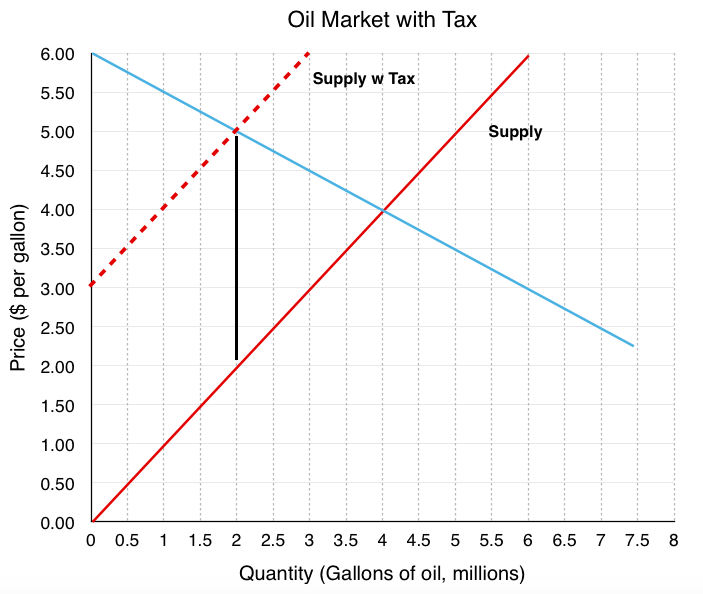
What if the legal incidence of the tax is levied on the consumers? Since the need curve represents the consumers' willingness to pay, the demand curve will shift down as a result of the tax. If consumers are only willing to pay $iv/gallon for 4 million gallons of oil simply know they will confront a $iii/gallon tax at the till, they will but purchase 4 million gallons if the ticket cost is $1. This creates a new equilibrium where consumers pay a $2 ticket cost, knowing they will take to pay a $3 tax for a total of $5. The producers will receive the $2 paid before taxes.
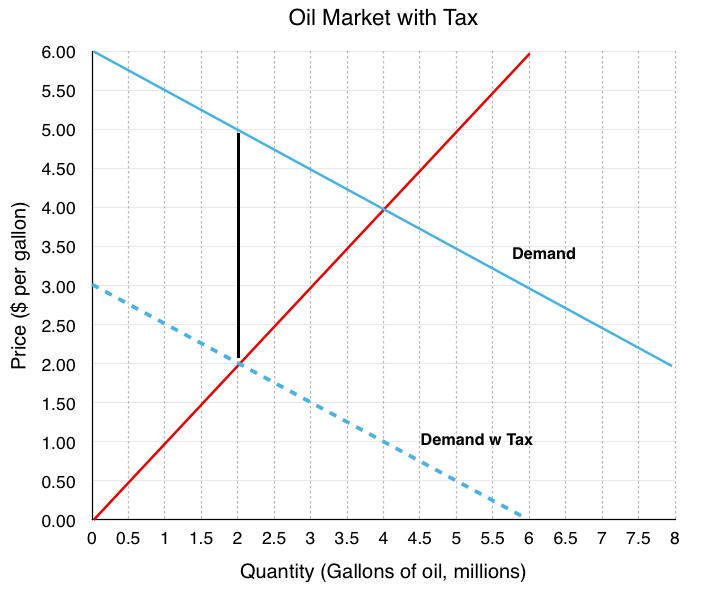
Note that whether the taxation is levied on the consumer or producer, the concluding result is the aforementioned, proving the legal incidence of the tax is irrelevant.
Taxation – The Wedge Method
Some other method to view taxes is through the wedge method. This method recognizes that who pays the revenue enhancement is ultimately irrelevant. Instead, the wedge method illustrates that a tax drives a wedge betwixt the price consumers pay and the revenue producers receive, equal to the size of the tax levied.
Every bit illustrated beneath, to find the new equilibrium, 1 merely needs to observe a $3 wedge between the curves. The commencement wedge tested is just $0.seven, followed by $one.5, until the $3.0 tax is found.
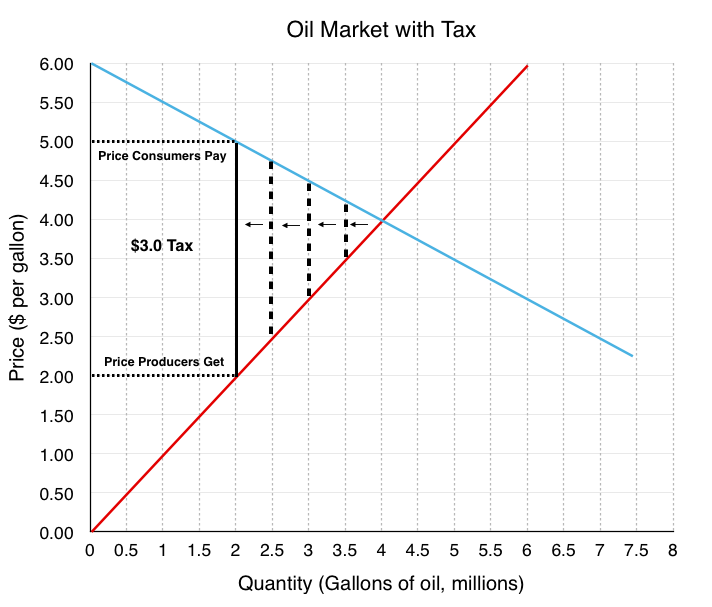
Market Surplus
Similar with cost and quantity controls, one must compare the market surplus before and after a price change to fully sympathise the effects of a tax policy on surplus.
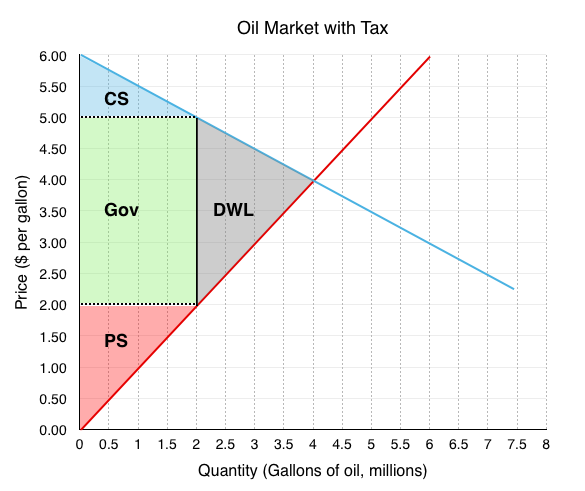
Before
The market surplus before the tax has not been shown, equally the process should exist routine. Ensure y'all sympathize how to become the following values:
Consumer Surplus= $4 million
Producer Surplus = $eight one thousand thousand
Market Surplus = $12 meg
After
The market surplus afterwards the policy tin exist calculated in reference to Figure iv.7d
Consumer Surplus (Blue Area) = $1 million
Producer Surplus (Red Area)= $ii million
Government Acquirement (Light-green Area) = $6 million
Market Surplus= $nine million
Why is Government Included in Market Surplus
In our previous examples dealing with market place surplus, we did not include whatsoever discussion of government revenue, since the government was non engaging in our market. Remember that market surplus is our metric for efficiency. If government was non included in this metric, information technology would not be very useful. In this case a million-dollar loss to government would be considered efficient if it resulted in a $i gain to a consumer. To ensure that our metric for efficiency is still useful nosotros must consider government when calculating market surplus.
As with the quota – both consumer and producer surplus decreased considering of a reduced quantity. The difference is, since the price is changing, there is redistribution. This fourth dimension, the redistribution is from consumers and producers to the government. Remember, but a change in quantity causes a deadweight loss. Price changes just shift surplus around between consumers, producers, and the regime.
Transfer and Deadweight Loss
Let's expect closely at the revenue enhancement's impact on quantity and cost to run across how these components affect the marketplace.
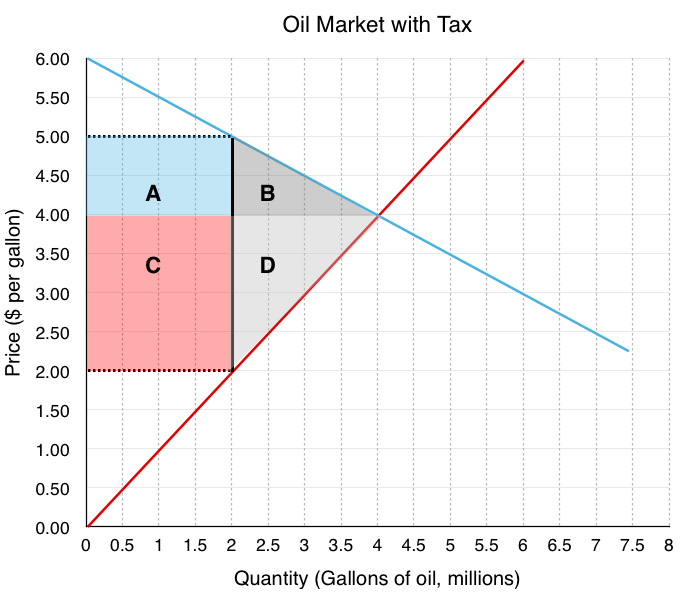
Transfer – The Affect of Cost
Due to the tax's issue on toll, areas A and C are transferred from consumer and producer surplus to government acquirement.
Consumers to Government – Area A
Consumers originally paid $4/gallon for gas. At present, they are paying $5/gallon. The $1 increment in price is the portion of the tax that consumers have to bear. Despite the fact that the tax is levied on producers, the consumers have to bear a share of the price change. The size of this share depends on relative elasticity – a concept we will explore in the adjacent section. This is because a subtract in price to producers means quantity supplied is falling, and in club to maintain equilibrium, quantity demanded must fall past an equal corporeality. This price modify means the government collects $1 x 2 million gallons or $ii million in tax revenue from the consumers. This is a directly transfer from consumers to government and has no consequence on market surplus.
Producers to Authorities – Area C
Originally, producers received revenue of $iv/gallon for gas. Now, they receive $2/gallon. This $2 subtract is the portion of the tax that producers have to bear. This means that the regime collects $ii 10 ii million gallons or $4 one thousand thousand in taxation revenue from the producers. This is a transfer from producers to the government.
As calculated, the regime receives a total of $6 million in tax revenue, which is taken from consumers and producers. This has no impact on net market surplus.
Deadweight Loss – The Impact of Quantity
If we just considered a transfer of surplus, at that place would exist no deadweight loss. In this example, though, nosotros know that price changes come up with a change in quantity. A higher price for consumers will cause a decrease in the quantity demanded, and a lower cost for producers volition cause a subtract in quantity supplied. This reduction from equilibrium quantity is what causes a deadweight loss in the market since at that place are consumers and producers who are no longer able to buy and supply the good.
Consumer Surplus Decrease – Area B
Due to the increment in toll, many consumers will switch away from oil to alternative options. This decrease in quantity demand of i.5 million gallons of oil causes a deadweight loss of $1 million.
Producer Surplus Decrease – Area D
Producers, who at present receive only $2.00/gallon for their production, will also decrease quantity supplied by 1.five million gallons of oil. Information technology is no coincidence that the size of the decrease is the aforementioned. When you create the wedge betwixt consumers and producers, yous are finding the quantity where the full amount of the tax is incurred just the market is still at equilibrium. Remember that quantity demanded must equal quantity supplied or the marketplace will non be stable. This mirrored decrease in quantity ensures this is however the case. Find, withal, that the bear on of this quantity drib causes a larger decrease in producer surplus than consumer surplus totalling $two million. Again, this is due to elasticity, or the relative responsiveness to the toll chance, which will be explored in more particular shortly.
Together, these decreases cause a $3 million deadweight loss (the difference betwixt the market surplus before and market surplus after).
Subsidy
While a tax drives a wedge that increases the price consumers have to pay and decreases the toll producers receive, a subsidy does the opposite. Asubsidy is a benefit given by the government to groups or individuals, usually in the class of a cash payment or a tax reduction. A subsidy is frequently given to remove some blazon of burden, and it is often considered to be in the overall interest of the public. In economical terms, a subsidy drives a wedge, decreasing the price consumers pay and increasing the price producers receive, with the government incurring an expense.
In Topic 3, we looked at a example report of Victoria'south competitive housing market where high need drove up prices. In response, the authorities has enacted many policies to permit low-income families to still get homeowners. Let's look at the effects of 1 possible policy. (Note the post-obit policy is unrealistic but allows for piece of cake comprehension of the event of subsidies).
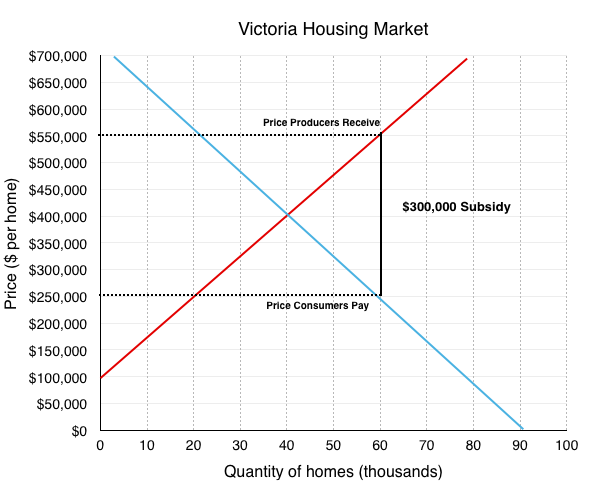
In the market place above, our efficient equilibrium begins at a price of $400,000 per home, with forty,000 homes being purchased. The authorities wants to substantially increment the number of consumers able to purchase homes, so it bug a $300,000 subsidy for any consumers purchasing a new home. This drives a wedge between what dwelling buyers pay ($250,000) and what domicile builders receive ($550,000).
With all government policies nosotros take examined so far, we have wanted to decide whether the consequence of the policy increases or decreases marketplace surplus. With a subsidy, we desire to practise the aforementioned analysis. Unfortunately, because increases in surplus overlap on our diagram, it becomes more complicated. To simplify the analysis, the following diagram separates the changes to producers, consumers, and government onto unlike graphs.
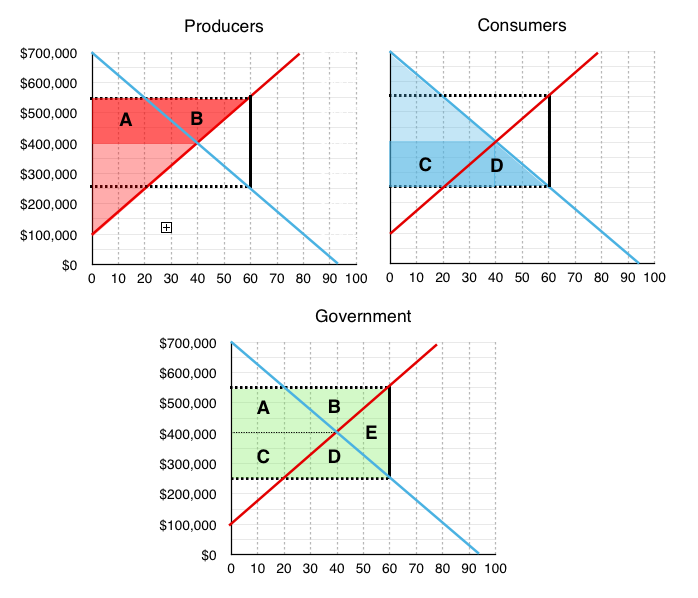
Producers
The producers at present receive $550,000 instead of $400,000, increasing quantity supplied to lx,000 homes. This increases producer surplus byareas A and B.
Consumers
The consumers now pay $250,000 instead of $400,000, increasing quantity demanded to threescore,000 homes. This increases consumer surplus pastareas C and D.
Government
The government now has to pay $300,000 per home to subsidize the 60,000 consumers buying new homes (this policy would toll the regime $xviii billion!!) Graphically, this is equal to a decrease in government to areas A, B, C, D and E.
Result
Our total gains from the policy (to producers and consumers) are areasA, B, C and D,whereas total losses (the cost to the government) are areasA, B, C, D, and E.To summarize:
AreasA, B, C and D are transferred from the government to consumers and producers.
Area Eastward is a deadweight loss from the policy.
In that location are two things to notice about this example. First, the policy was successful at increasing quantity from 40,000 homes to threescore,000 homes. 2nd, information technology resulted in a deadweight loss considering equilibrium quantity was besides high. Remember,anytime quantity is changed from the equilibrium quantity, in the absence of externalities, there is a deadweight loss. This is true for when quantity is decreased and when it is increased.
http://world wide web.investopedia.com/terms/s/subsidy.asp
Summary
Taxes and subsidies are more complicated than a toll or quantity control as they involve a third economic player: the government. As we saw, who the tax or subsidy is levied on is irrelevant when looking at how the market ends up. Notation that the concluding three sections have painted a fairly grim picture near policy instruments. This is because our model currently does not include the external costs economic players impose to the macro-surroundings (pollution, disease, etc.) or attribute whatsoever pregnant to disinterestedness. These concepts volition be explored in more than detail in subsequently topics.
In our examples in a higher place, we meet that the legal incidence of the tax does not thing, but what does? To determine which party bears more than of the brunt, we must employ the concept of relative elasticity to our analysis.
Glossary
- Economic Revenue enhancement Incidence
- the distribution of tax based on who bears the burden in the new equilibrium, based on elasticity
- Legal Tax Incidence
- the legal distribution of who pays the tax
- Subsidy
- a do good given past the regime to groups or individuals, usually in the form of a cash payment or a taxation reduction It is ofttimes to remove some type of brunt, and it is ofttimes considered to be in the overall involvement of the public
Exercises four.7
Refer to the supply and demand curves illustrated beneath for the following THREE questions. Consider the introduction of a $20 per unit tax in this market.
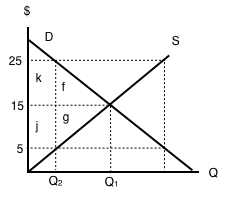
ane. Which areas represent the loss to consumer AND producer surplus as a result of this tax?
a) k + f.
b) j + g.
c) g + j.
d) k + f + j + g.
2.Which areas correspond the proceeds in government acquirement as a result of this revenue enhancement?
a) k + f.
b) j + yard.
c) k + j.
d) k + f + j + thousand.
three. Which areas represent the deadweight loss associated with this tax?
a) f + g.
b) k – g.
c) j – f.
d) k + f + j + thousand.
4. Presume that the marginal toll of producing socks is abiding for all sock producers, and is equal to $5 per pair. If government introduces a abiding per-unit tax on socks, then which of the following statements is FALSE, given the afterwards-revenue enhancement equilibrium in the sock market? (Assume a downward-sloping demand curve for socks.)
a) Consumers are worse off as a effect of the taxation.
b) Spending on socks may either increase or subtract as a result of the tax.
c) Producers are worse off as a upshot of the tax.
d) This tax volition result in a deadweight loss.
5. Refer to the supply and demand diagram beneath.
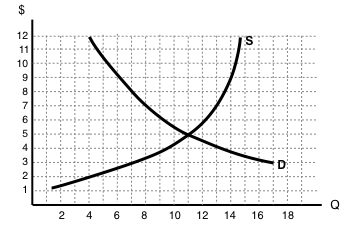
If an subsidy of $three per unit is introduced in this market, the cost that consumers pay will equal ____ and the price that producers receive net of the subsidy will equal _____.
a) $2; $5.
b) $3; $6.
c) $4; $7.
d) $5; $8.
vi. If a subsidy is introduced in a market, and then which of the following statement is TRUE? Presume no externalities
a) Consumer and producer surplus increase but social surplus decreases.
b) Consumer and producer surplus subtract just social surplus increases.
c) Consumer surplus, producer surplus, and social surplus all increase.
d) Consumer surplus, producer surplus, and social surplus all decrease
Utilize the diagram below to respond the post-obit Ii questions.
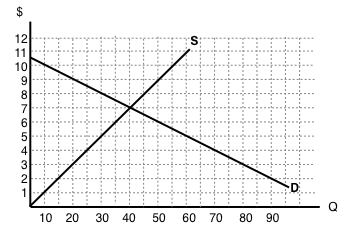
7. If a $6 per unit tax is introduced in this market, then the price that consumers pay will equal ____ and the price that producers receive net of the revenue enhancement will equal _____.
a) $x; $four.
b) $9; $3.
c) $8; $2.
d) $7; $1.
8. If a $6 per unit tax is introduced in this market, then the new equilibrium quantity volition exist:
a) 20 units.
b) forty units.
c) lx units.
d) None of the to a higher place.
9. Which of the following statements nigh the deadweight loss of revenue enhancement is TRUE? (Assume no externalities.)
a) If there is a deadweight loss, then the revenue raised by the tax is greater than the losses to consumer and producers.
b) If at that place is no deadweight loss, and then acquirement raised by the government is exactly equal to the losses to consumers and producers.
c) Both a) and b).
d) Neither a) nor b).
10. Which of the following correctly describes the equilibrium effects of a per-unit tax, in a market with NO externalities?
a) Consumer and producer surplus increment but social surplus decreases.
b) Consumer and producer surplus decrease only social surplus increases.
c) Consumer surplus, producer surplus, and social surplus all increase.
d) Consumer surplus, producer surplus, and social surplus all decrease.
11. Which of the post-obit correctly describes the equilibrium effects of a per unit subsidy?
a) Consumer price rises, producer price falls, and quantity increases.
b) Consumer price falls, producer price falls, and quantity increases.
c) Consumer cost rises, producer price rises, and quantity increases.
d) Consumer price falls, producer price rises, and quantity increases.
12. Refer to the supply and demand diagram below.

If an output (excise) tax of $v per unit of measurement is introduced in this marketplace, the price that consumers pay will equal ____ and the price that producers receive net of the tax volition equal _____.
a) $five; $10.
b) $vi; $eleven.
c) $vii; $12.
d) $8; $3.
13. Consider the supply and demand diagram beneath.
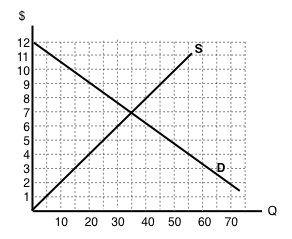
If a $2 per unit of measurement subsidy is introduced, what will be the equilibrium quantity?
a) xl units.
b) 45 units.
c) 50 units.
d) 55 units.
Consider the supply and need diagram below. Presume that: (i) there are no externalities; and (2) in the absence of regime regulation the market supply curve is the 1 labeled S1.
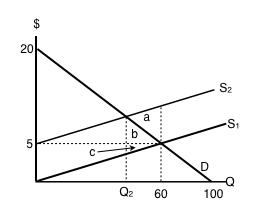
14. If a $v per unit of measurement tax is introduced in this market, which area represents the deadweight loss?
a) a.
b) a + b.
c) b + c.
d) a + b + c.
Source: https://pressbooks.bccampus.ca/uvicecon103/chapter/4-6-taxes/
0 Response to "What Is the Basic Difference Between Using a Subsidy to Induce Producers to Install"
Post a Comment